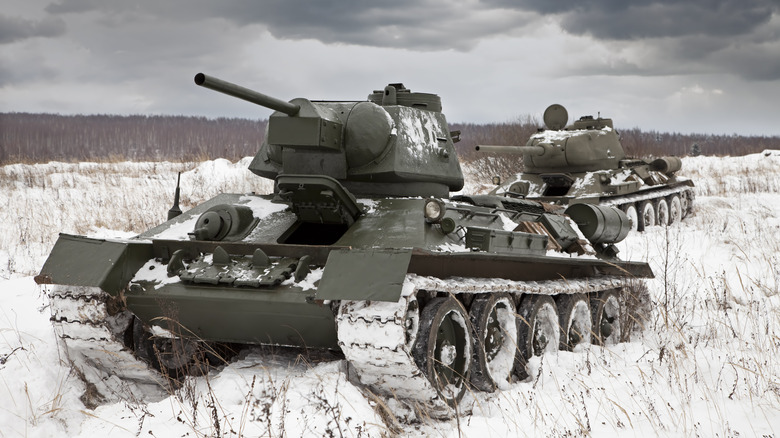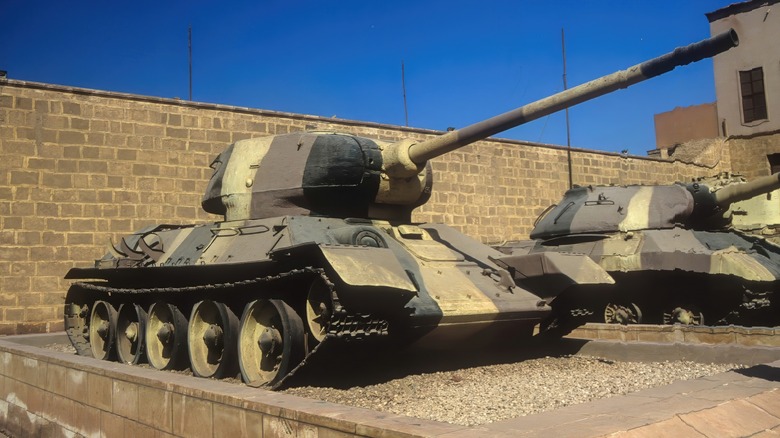What Is The Oldest Military Tank Still In Service?
Military history is a humbling area of study, especially with so many veterans to give us first-hand accounts of their experiences. But there are physical artifacts that tell stories of war's powerful past as well. Military tanks born of long-ended conflicts are the perfect vessel for such histories, while some continue to play their part in the modern era. There are military tanks that remain in service over many decades, proving that age doesn't always correspond to usefulness.
The oldest military tank still in service is the T-34, a behemoth with impressive specs first manufactured by the Soviet Union in 1940. As you might've guessed by the year, it played a major role in World War II, and Allied victory secured its survival after the war's conclusion. Yet, after eight decades, why would such a tank still be in use?
As with most historical enigmas, economics can provide an answer. It's easy to assume that technological advancements render the previous generation's tools of war obsolete. But on the global stage, poor and ostracized countries rely on whatever matériel they can muster. The T-34 can still be found in Cuba, Vietnam, Yemen, and North Korea, where militarization, embargos, and economic difficulties have led to the continued use of WWII-era technology.
The T-34 isn't the only tank in service that's eligible for a senior-citizen discount. The American M3 Stuart also has yet to quit, and operational variants of the Brit's Centurion tank can still be found in South Africa. However, the same theme emerges in all examples: just because technology is old doesn't mean it needs to be retired.
The origins of the T-34: An innovation to help win the war
The T-34 wasn't always a dinosaur. When it was first released in 1940, it was considered a cutting-edge piece of machinery. Even the Germans were impressed if not also dismayed. The T-34's superiority against Germany's polarizing Panzer tanks was apparent to both sides at the onset of Operation Barbarossa in 1941.
One of its greatest innovations was its 60-degree sloped armor, which could deflect anti-tank shells with improved consistency. It also had a debilitating 76.2mm main gun and double 7.62mm machine guns, a three-gun array that provided ample coverage. The huge size of the T-34 was also a big advantage, albeit an expensive one.
The T-34 was clearly a success for the Soviets. It was the most-produced military tank ever built by the war's end, with around 57,300 units between 1940 and 1945. To put that number in perspective, a 2020 article by Tank Roar calculates that the total number of tracks used in the T-34's wartime production could be laid out to span the distance from London to Warsaw. When you factor in the T-34 export models sold to foreign countries and additional units built after the war, the number climbs to around 84,000 T-34s in total.
Its predecessor the T-54/55 would eventually take the crown for most units built, with an estimated 85,000 to 100,000. Nonetheless, the sheer quantity of T-34s built over five years of war is staggering. That accolade came with a few other records, though none quite as brag-worthy. The T-34 was also the most destroyed tank during the war, with around 45,000 tanks lost to combat and break-downs.
Where and why the T-34 still serves
The T-34 is still in service, but not with its makers. The Soviets no longer employ it — most easily explained by the total collapse of the Soviet Union in 1991. However, Yemen, Vietnam, North Korea, and Cuba continue to use their export models in their armed forces, purchasing them during the Cold War.
After World War II, the North Korean People's Army used the T-34 to invade the south of the peninsula in the 1950s, kicking off the Korean War. This is a prime example of the proxy wars that defined the Cold War era when the United States and its allies clashed against the Soviets without direct military confrontation. And even with the precarious end to the Korean war, North Korea would keep that Soviet matériel in their arsenal into the modern age.
In the 70s and 80s, the Soviets supplied Cuba with T-34s, this time to bolster communist forces in the Angolan Civil War. They also sent several to help the Cuban Revolutionary Armed Forces. By the Bay of Pigs Invasion in 1961, the Caribbean nation had several T-34s poised and ready, a tank division that Cuba retains to this day. Vietnam also got its fair share.
Until as recently as 2019, the Republic of the Congo, Guinea-Bissau, Namibia, Laos, and Guinea also had serviceable T-34s in their arsenals. Many of these countries were targets of the Soviet Union's sphere of influence, so it's no surprise that they were supplied with Soviet-brand tanks. But when the Soviet Union fell in 1991, the material remnants of its endeavors remained. The T-34 tank still boasts the same firepower once feared by German invaders, yet now it serves more as an anachronistic reminder of the past.


